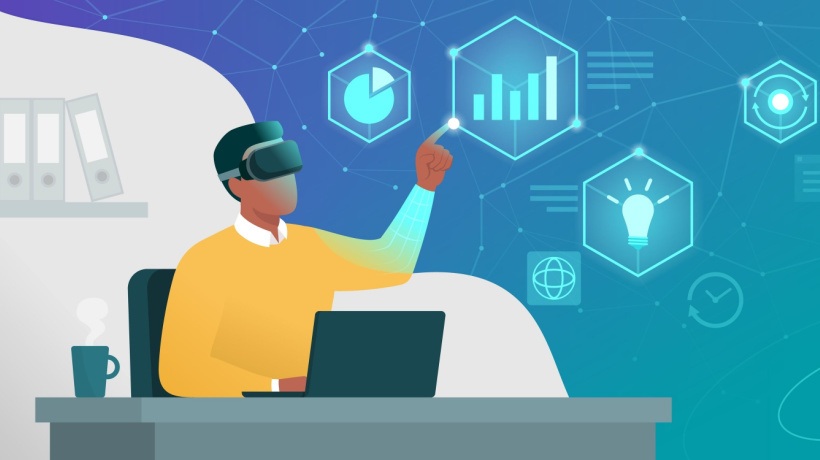How Can You Make The Most Of Immersive Experiences In VR?
This article is part of a series that provides options for learning teams to quickly create immersive learning, including one that allows you to simultaneously practice using the software. What you are about to read is a fable. The company, AshCom, is fictional, but the learning challenges faced by Kathryn, AshCom’s CLO, and her team are real and commonly shared by learning teams in large organizations. It is our hope that you will be able to connect with the characters, their challenges, and the solutions they discover. We also invite you to read the first eBook in the series.

The Victory
Ronda, AshCom’s Vice-President of Sales, knocked on Kathryn’s open office door and smiled. “We won!” was all she said. Kathryn, the Chief Learning Officer at AshCom, had been waiting for weeks for an update.
AshCom had been asked to submit a bid to manufacture a medical device that would be used in knee replacement surgery. It was one of the largest bids in AshCom’s history and was an entrance into the lucrative field of manufacturing medical devices.
When Ronda was putting together the bid with her sales team leaders, she thought it would be advantageous to include a demonstration of the device that the client’s sales team could try. She was looking for a way to stand out among others bidding for the contract, so she asked Kathryn if her learning team could come up with a solution that would show their creativity.
“I got a call from their contracting department this morning,” said Ronda. “They were impressed with our manufacturing process and our quality. They also said the immersive demonstration we committed to building was a key element in their decision. I hope your team is ready to get to work.”
Kathryn leaned back in her chair, exhilarated. “My learning team has never been involved in winning a bid. They are extremely excited about the opportunity, and they can’t wait to get into the world of immersive learning.”
Ronda replied, “I know you said you would build a Virtual Reality experience that would demonstrate the device and show how it would be used in surgery. Are you ready to get started?”
“We are,” said Kathryn with a little more hesitation in her voice than she intended. “I need to talk with Kurtis, our CFO, to find out what kind of budget we will have to get this done.”
“I already spoke to him,” said Ronda. “He was the first person I told when I got off the call. I’m pretty sure you will have the support you need. Do you have the pieces in place?”
“We do,” replied Kathryn. “We’ve identified an Extended Reality platform from a company we’ve worked with before, MindSpring. They will build what we need. Their team will work with our team, and we will build what we need together.”
“Sounds like a good plan,” said Ronda. “Let me know how I can help.”
“Will do,” said Kathryn as Ronda turned to leave.
Immersive Experiences In VR: Reaching Out To MindSpring
Once again alone in her office, Kathryn thought about what she needed to do next. Her first call was to Amy, a learning consultant who first told Kathryn about the MindSpring solution. Amy was excited for Kathryn when she heard the news. This would be the first time AshCom produced something using immersive technology.
Amy suggested that she put Kathryn in contact with Joe, the developer on the immersive technology team at MindSpring who originally built and led their innovation team. The three of them could hold a kickoff meeting to bring Joe up to speed on the project and begin to talk about solutions. The meeting was set for the following morning.
Amy kicked off the call by asking Joe and Kathryn to introduce themselves. Kathryn talked about AshCom broadly as a manufacturer and about her own experience in leading the learning team. Joe talked about his background in media and learning, and he walked Kathryn through why MindSpring developed the software in the first place.
With the introductions completed, Joe asked Kathryn to describe what she had in mind for this project.
Kathryn replied, “I want you to know that I’m open to suggestions, but I think we want to build an immersive experience in Virtual Reality that shows the medical device from all angles. Something that end users can manipulate. I would also like the VR experience to show how it can be used in knee replacement surgery. Our goal is to arm salespeople with a unique tool to show surgeons the full capacity of this device.”
“Makes sense,” said Joe. “Just so I understand this correctly, AshCom will be building the device designed by the company that awarded you the bid.”
“Correct,” said Kathryn.
“To build that device,” said Joe, “you will be building machines to make that device?”
“Yes,” said Kathryn. “When we manufacture things for other companies, they show us what they want to be manufactured, and then we make the tools and machines to do that. We have a lot of engineers who design and build our machines.”
“And then,” said Joe, “you must train your employees on how to run those machines, how to maintain them, and how to do quality control?”
“Sounds like you’ve worked with companies like AshCom before,” replied Kathryn.
“We have,” said Joe, “but I’m getting a little ahead of myself. The first order of business then is getting a design and the specifications of the knee replacement device. We can start there, and this can be done while you are ramping up for production. It would be good for their salespeople to be out selling the devices before production has begun. I’m guessing your customer would appreciate that.”
We Build Together
“I’m sure they would,” said Kathryn. “Amy described your ‘We Build Together’ option, and this makes a lot of sense to me. I want my team to learn how to use MindSpring’s software so that we can build more immersive learning in the future.”
“We hear that a lot,” said Joe. “I can walk you through how that works. Think of it as a process in which we begin and you observe as your team becomes more familiar with MindSpring’s software. As they get more comfortable, your team will be more engaged with the tool. As that happens, we become more like coaches so that by the end of the first project, your team will have some basic skills in creating Extended Reality.”
“That’s what I’m hoping for,” said Kathryn.
“We can get started on that process fairly quickly,” said Joe. “We will get a proposal to you that will lay out the process, price, timeline, and deliverables.”
“Perfect,” said Kathryn.
“I want to mention something else,” said Joe. “We have done a lot of work with companies like AshCom that design, build, and operate machines used in manufacturing. I think I might have some options for you to consider.”
Joe continued, “MindSpring has used their platform to help people design machines using 3D modeling capabilities so that the people running them can have a deeper understanding of how the machines work. It helps in the design too.”
“Now we are into an area more familiar to me,” said Kathryn. “We are talking about learning.”
“Yes,” said Joe. “We’ve built Augmented Reality learning experiences that get operators up to speed more quickly and produce better results. Once we build the learning, it can be delivered in almost any format, from instructional manuals to videos to 3D. We can even build Extended Reality learning experiences so that your operators can practice on the machines before they start working with the machines.”
“Amy mentioned that too,” said Kathryn. “She called it ‘One In/Many out,’ which I understood to mean that we create one experience that can be used in many modalities.”
“Correct,” said Joe. “It is a big part of what makes MindSpring’s software unique: you don’t have to rebuild a learning experience every time you want to deliver it in different modalities or realities across various devices. Before touching the machine, your operators can be immersively taught how to do their jobs. Then they can demonstrate what they’ve learned on the machine when it is ready. At that point, they will be ready to start manufacturing.”
The Maintenance Challenge
“You mentioned maintenance, which is a big deal for AshCom,” said Kathryn. “What does that look like?”
“For some customers,” said Joe, “we build just-in-time Augmented Reality so that they can see exactly what needs to be done to keep their machines in good working order. We find that at about the three-month mark, people who have been taught a procedure stop doing some of the steps. This reinforces what they learned and ensures that maintenance is performed in the right order when it needs to be done.”
“I’m interested in learning more about that,” said Kathryn. “We have a lot of maintenance programs that could benefit from that.”
“Let’s talk about quality control,” said Joe. “I’m assuming when the medical devices get to the end of the line, there’s some planned process for visual inspection to be done before they get shipped.”
“Correct,” said Kathryn.
Joe continued, “Most companies still use analog processes such as a pen and paper, or using a marker to note defects on the actual part. Leveraging MindSpring’s platform in this situation can bring great value quickly in several ways.
“First, by digitizing the process we can continuously monitor data gathered during an inspection. The system works by leveraging the device’s CAD to create an Augmented Reality that is a one-to-one relationship between the virtual part and the real world.
“Once that’s established, a standard inspection checklist can be overlaid directly on the real-world part. Each time an inspector makes a decision, a photo of that decision is captured and stored. This ensures that all inspectors are doing the inspection the same way every time, and it creates an archive of the inspection that can be referenced in case any issues arise during or after shipping.
“Finally, these photos can be used to recognize patterns so that at some point, you can install fixed cameras to execute the inspection process automatically if you decide to. Team members can focus on more complex processes.”
Inspect And Collect
Joe knew this was a lot to consider, so he gave Kathryn a moment and then continued.
“We call this ‘Inspect and Collect,” he said. “It is an augmented reality program of MindSpring’s technology in which images of the parts you produce are inspected by the software. That data is collected so that you have records of the parts you’ve built. If you are having quality control issues, you will know about them quickly and be able to address them before any bad parts are shipped.”
“This is important,” said Kathryn, “given that we are making devices that are used during surgery. People’s health is at risk, so we have to make sure that never happens.”
“The stakes are high,” replied Joe.
Amy had been quiet, listening to the conversation between Joe and Kathryn and taking careful notes. She decided this was a good point to confirm what she’d heard.
“Let me jump in if you don’t mind,” said Amy. “I’ve heard this grow from one project to the possibility of several immersive projects. Let me see if I kept accurate notes.”
“Fire away,” said Kathryn.
“The first project,” said Amy, “is creating an Extended Reality experience based on the actual medical device. The specs will come from the client. The MindSpring team will use these specs to build a virtual medical device that can be manipulated. We will also build a virtual simulation for how the device will be used in surgery. The subject matter experts will come from the company that designed it.”
“Correct,” said Kathryn.
“We’ve discussed a second project,” said Amy, “that would involve building the machines that will make the devices. The subject matter experts would be the engineers of AshCom who will design these machines in CAD. Those designs will be used by MindSpring to build immersive models that will educate operators on how the machines work and the processes needed to run them.”
“Yes,” said Joe.
“A possible third project,” said Amy, “is related to instructing the operators on the processes necessary to build the medical devices. Included will be the steps of operations and maintenance which will speed up production and produce quality devices. This learning can be delivered however the learning team at AshCom would like, whether instructional manuals, videos, 3D animations, and Augmented or Virtual Reality.”
“Our learning team will need to work through the components of these processes,” said Kathryn, “but we know that we would have a lot more tools to work to build them.”
“The last possible project,” said Amy, “was something Joe called ‘Inspect and Collect’ that AshCom machine operators can use to ensure quality control and track their performance. This would most likely be Augmented Reality.”
“Correct,” said Joe. “I can show you some examples of how other manufacturing companies have done this, which I think will be helpful.”
“Did I miss anything?” asked Amy.
“I don’t think so,” said Kathryn. “At the beginning of this conversation, I was excited about just creating a virtual reality experience focused on the medical device. It turns out that there are a lot more possibilities than I could have imagined. I think our C-Suite leaders will be interested in learning more about these options. It could revolutionize what we do and how we do it.”
“I’m willing to help however I can,” said Joe. “We’ve been doing projects like this for a long time. The technology is powerful if applied in the right way and connected to good learning.”
“Music to my ears,” said Kathryn. “I need to move on to my next meeting. Amy, thank you for connecting me to Joe. Joe, thank you for your time this morning. This has been educational, to say the least. I look forward to receiving some samples and descriptions of each of these services along with timelines and preliminary budgets.”
“Give me two days and I will get them to you once I have reviewed these potential projects with my team,” said Joe. “Thank you both for your time today.”
Conclusion
Download the eBook Your Immersive Learning Launchpad: The Ultimate Guide To Launching XR Learning to discover how you can implement XR in your organization to make the most of modern tech and minimize on-the-job mistakes. You can also join the webinar to learn how to build incredible learning experiences in extended reality.
Dear Reader, if you're excited to learn more about how you can integrate immersive experiences into your learning strategy, schedule an XR Needs Assessment with a MindSpring Learning Expert. We’ll answer any questions you have and show you how we’ve successfully implemented immersion into learning.










